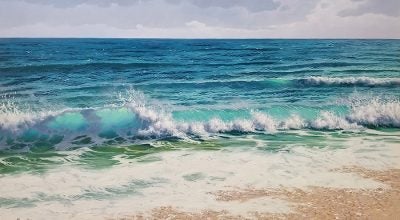14th Annual Pocosin Arts Cabin Fever Reliever a Success.
Published 3:55 pm Thursday, February 20, 2014

Aaron Iaquinto plays an instrument made in his mixed media class which focused on making instruments out of found objects or tin boxes or cans.
The 14th Annual Pocosin Arts Cabin Fever Reliever workshop was held in Columbia this past week from Feb. 13 to 16.
Participants from all over the country came to work, mingle, and enjoy the company of a fellowship of artists.
Professional artists led five workshops. In between workshop sessions attendees could take in the sights and sounds of the town.
Joshua Craig started his position as Pocosin Arts’ new Program and Marketing Coordinator in January.
He said the event was well-received in Columbia.
“Local restaurants such as the Old Salt Oyster Bar and Sandy’s Place opened their doors and catered delicious meals to rave reviews. Public lectures were given by the workshop instructors each night in the Scuppernong Millhouse. Friday night saw the Alligator String Band stop by for a jam session with special guest and workshop instructor Aaron Iaquinto on the mandolin,” said Craig.
Any of the participants who had made artwork could sell their wares in the Mill House gallery and Pocosin Arts even held a silent auction of donated works by instructors and participants alike. The new Riverside Lodge was buzzing with activity in addition to the ceramics and metals studio at 201 Main Street.
Pocosin Arts also took over the Riverview house and with the help of Durwood Cooper Jr. made use of the vacant space next to Village Realty. Several East Carolina University students attended the retreat as well—many of whom received a scholarship to attend.
“I hope people got to enjoy Columbia as a town while they were here for the retreat and really got to embrace the whole experience,” said Craig.
Aaron Iaquinto lead a mixed-media workshop which focused on helping each participant create a unique stringed instrument with found objects and a tin box or can of a participant’s choice.
“The goal of the course is to find the inherent sound within the material and give it voice,” reads a description of the course from a brochure on the entire Cabin Fever Reliever event.
One purpose of the course was to show that it is possible to make instruments with whatever materials are available.
“You do not need to go buy an expensive guitar if you want to make music. You can go at it on your own,” said Iaquinto.
The instruments built in the class were going off the concept of the diddley bow, a single-stringed American instrument which influenced the development of the blues sound.
“The idea is back in the day they did not have guitars. They did not have anything to use so they would attach a clothes-line to the side of the barn. They would take a coke bottle and just play it. They would move the coke bottle along the line and get cool sounds,” said Iaquinto.
All the instruments being prepared in the class were going to be electric.
“That kind of gives a little bit of an edge to things. Because you can put effects on it and try different stuff,” said Iaquinto.
Iaquinto currently lives in Raleigh, North Carolina where he plays the mandolin, builds his instruments, carves wooden spoons, and works in a cabinet shop. He received a Bachelor of Fine Arts with a concentration in wood design at East Carolina University.
C. James Meyer is professor Emeritus at Virginia Commonwealth University where he was head of the Metal and Jewelry program. He currently maintains a studio and continues to teach part-time. This includes teaching in the University of Georgia Studies Abroad Program in Cortona, Italy as well as conduction workshops at Penland School of Crafts in North Carolina and Peters Valley in New Jersey.
Meyer led a workshop focused on the basics of ring-making.
“It is designed for the beginner and for those wishing to advance their fabrication skills. It will cover the basic band ring (including variations), a forged ring, and a hollow fabrication ring. Additionally, we’ll cover basic bezel setting of a cabochon stone,” reads a provided description of the course.
Craig said that Columbia was very lucky to have Meyer teaching at Cabin Fever Reliever 2014.
“The full class with Meyer is working with silver and precious metals. They learn how to forge and fabricate rings of all shapes and sizes. He will be doing stone-setting as well,” said Craig during a walk-through that he gave of all the courses held around downtown Columbia.Ty Nicholson, a teaching assistant, filled in for Kelley Garret Rathbone’s Expressive Portrait Workshop on Thursday.
Ty Nicholson, a teaching assistant, filled in for Kelley Garret Rathbone’s Expressive Portrait Workshop on Thursday.
Rathbone was delayed in Dulles International Airport and was scheduled to teach on Friday.
Nicholson is a graduate student at Georgia State University’s College of Art and Sciences. He also teaches at a nearby art center in Atlanta.
Nicholson mentioned that this was his first time coming to Columbia.
“I have been here for two days. Coming to the Lodge has been the best part so far,” he said.
In the portrait workshop, students explored personal narratives by sculpting s small to medium-sized busts that were supposed to be gestural and expressive.
Faye Davis Edwards is a professional studio artist living and working on the Outer Banks of North Carolina. She earned her BFA in painting from East Carolina University in Greenville,NC. where her concentration centered primarily on figurative painting in watercolor. She currently is the Gallery Director for the Dare County Arts Council.
Edwards led a mixed a media class structured around painting, drawing, and collage work.
“It is primarily word-color painting that we are introducing other elements into. We have got acrylic that we are going to use as well as graphite, and hand-made paper. The thrust behind it is that we are going to be creating new narratives for old books,” said Edwards.
Edwards noted that her class involved first flooding the paper and getting a ground to work on.
“Then you paint in your image with a basic form and react to that. You start introducing where your light source is going to be and what other visual textual elements need to show up in here,” she said.
Edwards outlined some changes done to a 1880s’s book on Sea Monsters.
“Totally unrelated things. The book was falling apart, it was going to be thrown away. At least elements of it can live somewhere else,” she said.
Edwards said that she was attending her 14th Cabin Fever Reliever out of the 14 held in all.
She has taken four different classes and this is the first time she has taught a class.
Edwards mentioned that she comes to Columbia monthly.





